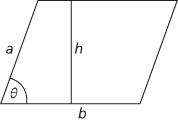A quadrilateral in which (i) both pairs of opposite sides are parallel and (ii) the lengths of opposite sides are equal. Either property, (i) or (ii), in fact implies the other. The area of a parallelogram equals ‘base times height’. That is to say, if one pair of parallel sides, of length b, are a distance h apart, the area equals bh. Alternatively, if the other pair of sides have length a and θ is the angle between adjacent sides, the area equals absinθ, so the area also equals |a×b|, the magnitude of the vector product of the sides as vectors.

A parallelogram
- contact
- contact angle
- contact aureole
- contact binary
- contact bounce
- contact force
- contact forces
- contact goniometer
- contact insecticide
- contactless smartcard
- contact lithography
- contact metamorphism
- contact noise
- contactor
- contact potential difference
- contact process
- contact resistance
- contact twin
- contagion
- contagious distribution
- contained fragments
- contained in
- container
- containment
- contaminant control cartridge